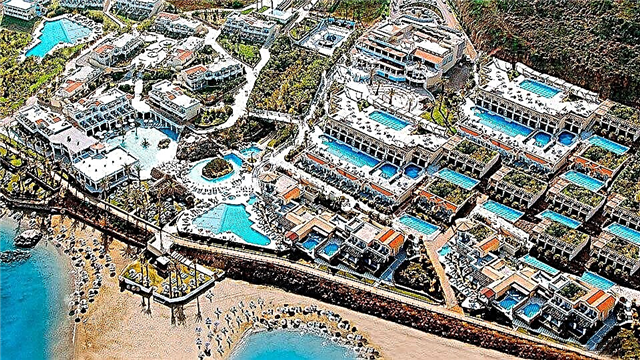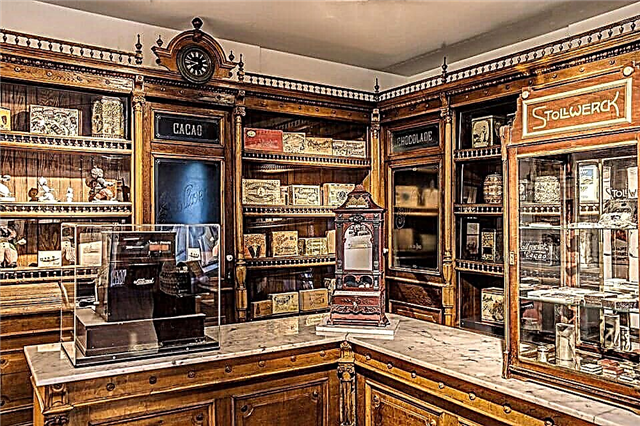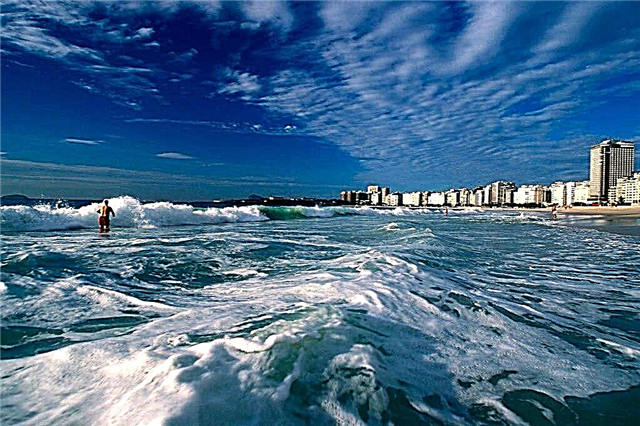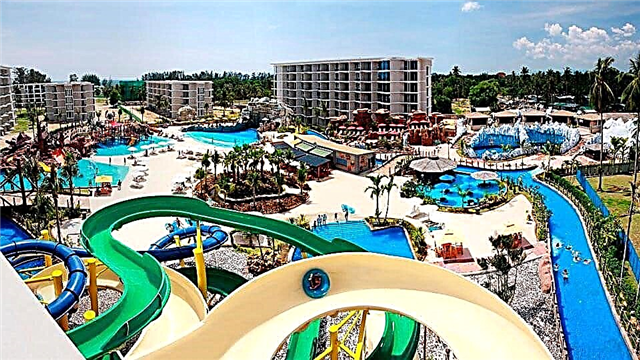Address: France, city of Strasbourg, Cathedral Square
Start of construction: 1015 year
Completion of construction: 1439 year
Height: 142
Main attractions: astronomical clock, column of Angels, baptismal font of the 15th century, the image of the Mount of Olives, the portal of St. Lawrence, cathedral pulpit, stained glass windows of the 12th-14th centuries, tapestries of the 17th century
Coordinates: 48 ° 34'54.7 "N7 ° 45'03.3" E
Content:
Short description
If you try to highlight the most beautiful Catholic churches built at different times in the Gothic style, then their number, of course, will include the Strasbourg Cathedral in France.
Running a little ahead, I would like to note that earlier this temple was not only Catholic: Protestants also attended services held in this magnificent building. The splendor of this cathedral is rather difficult to describe in words, although it, like the Cologne Cathedral, is still considered unfinished. What is the fact that for more than two centuries this building was considered the tallest on our entire planet!

North facade of the cathedral
If you carefully study the written works of historians and architects, you can easily draw a certain conclusion: Strasbourg Cathedral, dedicated to the Holy Virgin Mary, is rightfully considered one of the most beautiful and largest Catholic churches in the world Of the Old World. Every day, thousands of guests of the French city come to him to see firsthand the miracle that has appeared in the world thanks to the joint work of German and French architects. By the way, Strasbourg itself, although it is part of France, can be called a city where two cultures are surprisingly intertwined: German and French. Speaking about this temple, built of sandstone, it should be emphasized that it is the Catholic church of the bishop: today you will not find Protestants in its huge halls.
Strasbourg Cathedral: the history of construction and architectural features
The earliest mentions of an unfinished Romanesque church date back to 1015. However, thanks to archaeological excavations, scientists were able to prove that a Roman sanctuary stood on this site long before this period of time.

View of the western facade of the cathedral from the street Mercier
Initially, in 1015, the Strasbourg Cathedral was supposed to be built in the Romanesque style, as mentioned a little above. Moreover, the work had already begun: the order for the construction was given by Bishop Werner of Habsburg. For some unknown reason, the unfinished building was almost completely burned down. It was possible to restore the temple, at the cost of incredible efforts and huge investments, only by the end of the 12th century, and at that time the Gothic style had already become fashionable in Europe. For this reason, most parts of the building acquired more strict "airy" forms, and the decoration was made of reddish stones, which were specially brought to the construction site from the neighboring mountainous regions.
The bishop, who paid all the expenses for the restoration and reconstruction of the building, died, and the construction of the magnificent cathedral, which in the future would become the tallest building in the world, was temporarily stopped. The donations of the bourgeois were not enough, so all residents, without exception, began to make their feasible contribution to the construction of the Strasbourg Cathedral. a cozy city.

View of the north (142 m.) And south towers of the cathedral
The temple in Strasbourg, dedicated to the Holy Virgin Mary, may even remind an inexperienced traveler of the Cologne Cathedral. Indeed, they still have something in common. However, in the architecture of the bishop's church in Strasbourg, the influence of the Romanesque style can also be traced.
More precisely, due to numerous reconstructions, the building, erected from Vosges sandstone, is strikingly different from similar structures, which makes it unique and inimitable. The builders made the eastern part of the cathedral, the southern entrance and the choir in the Romanesque style, but the famous nave, where you can see countless figures, and the western facade were built in the Gothic style.
Interestingly, the western part was built under the leadership of a German named Steinbach. Some documents even mention the fact that the architect and builder did not regret giving all his property for the construction of a magnificent temple. True, all his property at that time consisted of only one horse.

Strasbourg Cathedral portal
The most recognizable part of the building, with the exception of the astronomical clock, which should definitely be discussed in more detail below, is the spire built by Johann Hultz from ... Cologne. Probably, it is for this reason that many tourists find similarities in the two most beautiful Catholic churches. The North Tower, which reaches 142 (!) Meters in height, was completed in 1439. True, it became the highest in the world only in 1652. This record was broken only at the end of the 19th century. The builders probably "forgot" about the South Tower: they never started to build it. For this reason, Strasbourg Cathedral can be called an example of asymmetry in architecture (unless, of course, you take into account the masterpieces of Antoni Gaudi).
Treasures of the Strasbourg Cathedral
In Strasbourg Cathedral, every sculpture, every stained glass window and object is a real work of art, which cannot be estimated in monetary terms. Unfortunately, it will not be possible to describe them all in one material. It is best to see them with your own eyes or look at the photo.

Fragment of the facade of the Strasbourg Cathedral
It is definitely worth highlighting the sculptures that the traveler can admire over the triple portal: these are realistic statues of the great Prophets, the Magi, who carried messages from the higher powers to the people, and symbolic images of worldly vices and virtue.
Inside the Strasbourg Cathedral, you can see the magnificent baptismal font, which was made by the famous Dotzinger in the middle of the 15th century. Tapestries, the altar of St. Pancratius, stained glass windows stunning with their unearthly beauty and, of course, the astronomical clock are just a small part of what can be seen in one of the most beautiful Catholic churches in the world.
By the way, the astronomical clock of the Strasbourg Cathedral deserves special attention. The amazing and precise movement was developed by the watchmaker Schwilge, and the decorated case for them in the 17th century was made by Tobias Stimmer.

Fragment of the facade of the Strasbourg Cathedral
The mechanism of the unique clock has changed several times: the one that accurately calculates the days of Catholic holidays, and has the ability to show the precession of the earth's axis, has reached our time. Surprisingly, the slowest revolution in this watch lasts exactly 25,800 years. It is impossible to explain how it was possible to recreate such an accurate mechanism at a time when there was still no computer technology. The astronomical clock of the Strasbourg Cathedral attracts attention and, at times, does not allow you to focus on anything else. And the interior decoration of the temple amazes with its splendor: the organ, the oldest part of which was made by a master in the 14th century, a statue of a priest, whose speech is drawn to the moving figure of a sweets merchant ...
Strasbourg Cathedral: modern history and tourist guide
To our great regret, the French Revolution did not spare this temple: many frescoes and sculptures were destroyed. In fairness, it should be noted that the greatest damage to the Strasbourg Cathedral was caused by the bombing of the fascist aircraft and the forces of the anti-Hitler coalition.

View of the western facade of the cathedral
The temple, which was built by the French together with the Germans, was partially destroyed by them….The legendary tower survived, it survived thanks to one talented and resourceful blacksmith, who made a protective cap of the strongest metal for it after the devastating revolution.
Time passed, wars and hardships were left behind: after a thorough reconstruction carried out by the best specialists, the Strasbourg Cathedral appeared before the believers and guests of the city in its original form. Today this asymmetrical building is visited by thousands of tourists who want to see not only astronomical clocks, sculptures and other treasures, but also an amazing combination of French and German cultures.
Anyone can visit Strasbourg Cathedral in France absolutely free... It opens its portals at 7 am and closes at 7 pm. It is worth remembering that there is a break in the church from 11-30 to 12-40. All tourists who want to get to the North Tower will have to pay 4 euros and 60 euro cents for a ticket.

Astronomical clock of Strasbourg Cathedral
For children and adolescents, getting up is half the price. Coming to Strasbourg and not visiting its “heart” is an unforgivable mistake, because the great Hugo called it “a delicate and gigantic architectural miracle”. Goethe also described it in his writings, calling it nothing else than the "tree of God"!











